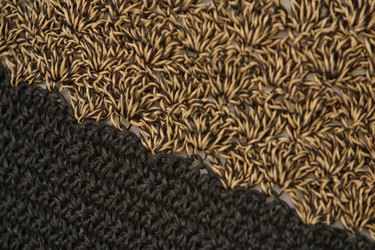
Finishing off a crochet piece can be satisfying, but there's another step that can take your project to the next level: blocking. Blocking a piece of crochet is a very easy process that can really change the character of your work for the better.
How to Block?
Video of the Day
There are several methods of blocking, including wet blocking, steam blocking, spray blocking and cold blocking. Generally, these methods all utilize some amount of water applied to the piece combined with stretching the piece into the desired shape. Use rust-proof pins to hold the piece in place. This ensures that it will not move around during the blocking process, which would render the process ineffective. When wet blocking, soak the piece in water before stretching and laying it into place. When steam blocking, pin the piece in place and use a steam iron or clothes steamer on it. Spray blocking is a similar process that uses a spray bottle filled with water rather than a steamer. Cold blocking is a good method for acrylics; pin the piece in place, lay damp towels over it and leave it until dry.
Video of the Day
Why Block?
Blocking takes your work from looking "homemade" to "handcrafted," meaning it looks professionally done and finished. Blocking helps the stitches lay flat and in a straight line, makes your edges smooth and helps the finished piece hold its shape.
When Should I Block?
Blocking is only done after a piece is finished. Once a piece is tied off and the ends are woven in, blocking can begin. If making a project with several pieces that require assembly, block each piece separately before assembling. Blocking pieces before assembly also helps the seams lie straighter and meet up more evenly than they would if you tried to block after assembly.
What Should Be Blocked?
Almost any crochet piece can be blocked. Wools are the easiest to block while acrylics can sometimes be impossible to block at all. However, there are blocking methods for each kind of yarn, so it's always worth a try. Read the information that comes on your yarn's label to help determine what method of blocking is appropriate.